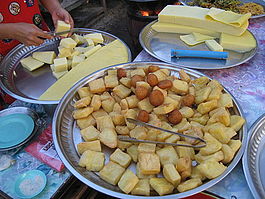

This article includes a list of general references, but it lacks sufficient corresponding inline citations. Please help to improve this article by introducing more precise citations. (February 2013) (Learn how and when to remove this message)
|

To hpu (Burmese tofu), in two forms: fresh and fritters
| |
| Place of origin | Burma |
|---|---|
| Associated cuisine | Burmese cuisine |
| Main ingredients |
|
Burmese tofu (Burmese: တိုဖူး, pronounced [tòpʰú]; or Burmese: တိုဟူး, pronounced [tòhú]) is a food of Shan origin and of Chinese from Yunnan Province, made from water and flour ground from yellow split peas and the Burmese version of chickpea flour, also known as besan flour, in a fashion similar to polenta.[1] The flour is mixed with water, turmeric, and a little salt and heated, stirring constantly, until it reaches a creamy consistency. It is then transferred into a tray and allowed to set. It can also be made using dried chickpea instead of processed flour. In this process, dried chickpeas are soaked overnight. Once the peas have been re-hydrated, they are ground into a puree with some of the liquid used to soak the peas, then allowed to set for a couple of hours. Much of the top layer of clear liquid is then skimmed off and the remaining puree is brought to a boil with turmeric and salt and cooked and set in the same manner as the version using chickpea flour. It is matte yellow in colour, jelly-like but firm in consistency, and does not crumble when cut or sliced. It may be eaten fresh as a Burmese tofu salad or deep-fried into a Burmese fritter.[2] It may also be sliced and dried to make crackers for deep frying. Despite the name, Burmese tofu is unrelated to Chinese tofu,[3] which is made from soy milk with added coagulants.

There is no /f/ (as in "French") in the Burmese language; hence, /pʰ/ (as in the word "pot") is used in to hpu, the Burmese version of "tofu".

Fried tofu goes very well with kauk hnyin baung (glutinous rice) as a breakfast option, and also with mohinga (rice vermicelli in fish soup), nan gyi thouk (rice noodle salad) and Shan khauk swè (Shan-style rice noodles). Green tea is the preferred traditional drink to go with all these in Burma.

|
| |
|---|---|
| |
| Salads |
|
| Rice dishes |
|
| Noodle dishes |
|
| Other dishes |
|
| Snacks |
|
| Drinks and beverages |
|
| Seasonings and ingredients |
|
| Miscellaneous |
|
| |